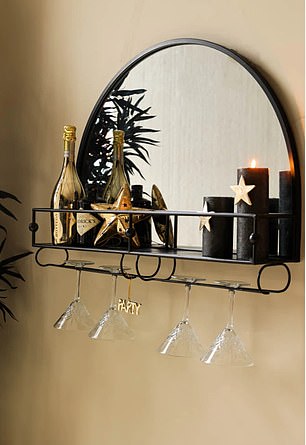Death of the dining room? How to breathe new life into the most neglected space in your home
They were once an important part of the home where families gathered for all important conversations.
But our once beloved dining room seems to have gone out of style.
In fact, the dining room is one of the most neglected rooms in the house.
According to a study by Toolstation, 25 percent of households with a dining room no longer use it.
Does this mean we have seen the death of the dining room?
Heart of the home: a family enjoying lunch in a traditional dining room – but 25% of households with a dining room no longer use it
“I’ve seen a big shift in attitudes toward the formal dining room,” says Katy Raywood, interior design consultant at Howson Design.
‘One of the biggest reasons has to do with the modern work-life balance.
‘Most couples both work, which can mean working different times and longer hours. This makes eating at different times more normal.
“And when you have kids, the dinner table becomes the dumping ground for crafts, homework and toys.”
So how can you bring your neglected dining room back to life?
Double purpose
Unloved dining rooms can be transformed by turning them into multi-functional spaces for work, study, creativity or mixing a cocktail.
Think about how you can accommodate at least two functions in your dining room, says Aarti Popat of Aarti Popat Interior Design.
“If you’d rather keep the space for entertaining, integrate a home bar into the space,” she says.
To make room for the addition of a bar, remove the dated dresser and traditional display cabinet.
If the room is small, consider a compact accessory such as a gold wall mirror with bar shelf from Rockett St George for £130.
If you have the space and fancy adding some glitz to your dining room, Popat suggests buying a freestanding bar with mirror for £1,895 and gold bar stools from the same company.
Homewares boutique Audenza has a range of nice accessories to give your bar some personality (from €30).
Adding a sofa to your dining room can serve as a snug or playroom for the kids to watch TV.
If you prefer to keep the room media-free, add a statement chair and reading lamp to create a quiet corner where you can get lost in a good book.

Cheers: A Rockett St George bar shelf, £130
Hero tables
Even if you want to shake off the formality of the room, your dining table and chairs (always choose comfort) should remain the focal point of the room.
A hard-wearing family table that can hold the children’s homework or a craft session can still be a striking feature.
“A wooden table is perfect for the whole family because of its rustic character,” says Raywood.
‘It doesn’t matter if it has a scratch or a bump and you can personalize it with different chairs of your choice.’
She recommends the Bespoke Collection from Hemming & Wills, with sale prices from £220.
A banquet-style folding table and chairs are a good space-saving option and the perfect compromise for using the dining room as an office when not in use.
Danetti.com has a range of extendable dining tables in a neutral palette from €494.
Dive into the decor
‘Metallic accents are a great way to make dining rooms feel more luxurious and modern,’ says Victoria Foster, interior stylist at ScS.
“Consider adding brass or stainless steel accents to create more interest through shelves, framed mirrors or the legs of your furniture.”
Changing your light fixtures and switches or introducing a sculptural lamp, updating your wall art or adding decorative pieces like vases can instantly give the room a fresher feel.
To update your color scheme, Foster recommends choosing rich colors such as olive green or royal blue.
‘Creating a feature wall with statement wallpaper is also a popular choice, just make sure it’s a pattern you’ll enjoy for years to come.’
Open or closed?
Open spaces remain popular, but not for everyone. Estate agents Strutt & Parker say homeowners should think twice before knocking down walls, as some buyers still like the option of having a private dining space.
Traditional dining rooms were often located in the brightest part of the house with the best views.
Instead of knocking down walls, consider moving your kitchen here.
If you want an open element but don’t want the space between your kitchen, dining room and living room to be completely open, you can partially cut through it and choose pocket doors to create separation.
Pocket doors are sliding doors that, when open, disappear into a compartment in the wall.
“Alternatively, you can knock down the wall and add glass partitions or double doors that can open the space to the outside when you need it,” says Popat. ‘My favorite are Crittall doors, sliding or folding doors.’
Focus on floors
If you’re a fan of an open plan kitchen/dining area, you can add definition between rooms using zone floors.
This is the combination of two floor designs that can be securely attached together, explains Anastasiia Kudashova, chief design manager of flooring expert Quick-Step.
In kitchen areas, a concrete look floor can help define a work area, while a contrasting wood effect floor can be used for living and dining areas.
“This design can help break up larger spaces and compartmentalize rooms without the need for walls or barriers,” she adds.
Consider a herringbone or chevron pattern for the dining and living areas and waterproof flooring such as laminate and vinyl to help deal with most common spills and accidents.
